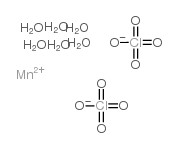manganese (ii) perchlorate
Modify Date: 2024-01-06 10:33:26

manganese (ii) perchlorate structure
|
Common Name | manganese (ii) perchlorate | ||
|---|---|---|---|---|
| CAS Number | 15364-94-0 | Molecular Weight | 361.93100 | |
| Density | 2.100 | Boiling Point | N/A | |
| Molecular Formula | Cl2H12MnO14 | Melting Point | 165ºC | |
| MSDS | N/A | Flash Point | N/A | |
| Name | Manganese(ii)perchlorate hexahydrate |
|---|---|
| Synonym | More Synonyms |
| Density | 2.100 |
|---|---|
| Melting Point | 165ºC |
| Molecular Formula | Cl2H12MnO14 |
| Molecular Weight | 361.93100 |
| Exact Mass | 360.89800 |
| PSA | 203.92000 |
| LogP | 0.04280 |
| Appearance of Characters | Crystalline Solid | Pink |
| Stability | hygroscopic |
| Water Solubility | Soluble in benzene, ethyl acetate | Soluble in water, benzene, ethyl acetate |
|
Section 1: Product Identification Chemical Name:Manganese (II) perchlorate hexahydrate, 99% CAS Registry Number:15364-94-0 Formula:Mn(ClO4)2.6H2O EINECS Number:233-108-3 Chemical Family:metal perchlorate salt Synonym:Perchloric acid, Manganese(II) salt, hexahydrate
Section 2: Composition and Information on Ingredients IngredientCAS NumberPercentACGIH (TWA)OSHA (PEL) Title Compound15364-94-0100%0.2mg/m35mg/m3 Section 3: Hazards Identification Irritating to eyes, skin and respiratory tract. Manganese affects the central nervous system. Perchlorates may Emergency Overview: affect thyroid and kidney functions Primary Routes of Exposure:Ingestion Eye Contact:Causes moderate irritation of the eyes. Skin Contact:Causes moderate irritation of the skin. Inhalation:May cause difficulty in breathing and irritate mucous membranes and respiratory tract. Ingestion:No information available on the physiological effects of ingestion. Acute Health Affects:Irritating to skin, eyes and respiratory tract. Prolonged exposure to manganese containing dust may produce manganese pneumonitis and manganese Chronic Health Affects:poisoning. Symptoms include sleepiness, weakness and emotional disturbances. Equivocal studies have shown manganese may decrease fertility in men. NTP:No IARC:No OSHA:No SECTION 4: First Aid Measures Immediately flush the eyes with copious amounts of water for at least 10-15 minutes. A victim may need Eye Exposure: assistance in keeping their eye lids open. Get immediate medical attention. Wash the affected area with water. Remove contaminated clothes if necessary. Seek medical assistance if Skin Exposure: irritation persists. Remove the victim to fresh air. Closely monitor the victim for signs of respiratory problems, such as difficulty Inhalation: in breathing, coughing, wheezing, or pain. In such cases seek immediate medical assistance. Seek medical attention immediately. Keep the victim calm. Give the victim water (only if conscious). Induce Ingestion: vomiting only if directed by medical personnel. SECTION 5: Fire Fighting Measures Flash Point:no data Autoignition Temperature:no data Explosion Limits:no data Extinguishing Medium:Water spray Spray closed containers with water until fire is out. Avoid contact with combustible material. Fire fighters Special Fire Fighting Procedures: should be equipped with a NIOSH approved self-contained breathing apparatus. Hazardous Combustion andIf involved in a fire this material may emit corrosive hydrogen chloride fumes. Decomposion Products: Releases oxygen on heating. May decompose explosively under fire fighting conditions. Do not mix with Unusual Fire or Explosion Hazards: combustibles. SECTION 6: Accidental Release Measures Do not mix spilled powder with any combustible materials, such as sawdust. Sweep up the solid and dilute Spill and Leak Procedures: with water. SECTION 7: Handling and Storage Store in a tightly sealed container in a cool dry place away from combustible and flammable materials. If the Handling and Storage: container is left open, salt will adsorb moisture from the atmosphere. SECTION 8: Exposure Controls and Personal Protection Eye Protection:Always wear approved safety glasses when handling a chemical substance in the laboratory. Skin Protection:Wear protective clothing and gloves. Ventilation:If possible, handle the material in an efficient fume hood. If ventilation is not available a respirator should be worn. The use of respirators requires a Respirator Respirator: Protection Program to be in compliance with 29 CFR 1910.134. Ventilation:If possible, handle the material in an efficient fume hood. Additional Protection:No additional protection required. SECTION 9: Physical and Chemical Properties Color and Form:pink xtl. Molecular Weight:253.84 (361.93) Melting Point:no data Boiling Point:no data Vapor Pressure:not applicable Specific Gravity:no data Odor:none Solubility in Water:Very soluble SECTION 10: Stability and Reactivity Stability:hygroscopic Hazardous Polymerization:no hazardous polymerization Conditions to Avoid:Any contact with combustible matter. Incompatibility:Reducing agents, organic matter, active metals, phosphorus, sulfur, hydrazine, hydroxylamine, strong acids Decomposition Products:Oxygen, Manganese oxide, hydrogen chloride, SECTION 11: Toxicological Information RTECS Data:Intraperitoneal (rat); LD50: 410 mg/kg. Carcinogenic Effects:No data available Mutagenic Effects:No data available Tetratogenic Effects:No data available SECTION 12: Ecological Information Ecological Information:No data available SECTION 13: Disposal Considerations Disposal:Dispose of according to local, state and federal regulations. SECTION 14: Transportation Shipping Name (CFR):Perchlorates, Inorganic, N.O.S. Hazard Class (CFR):5.1 Additional Hazard Class (CFR):NA Packaging Group (CFR):II UN ID Number (CFR):UN# 1481 Shipping Name (IATA):Perchlorates, Inorganic, N.O.S. Hazard Class (IATA):5.1 Additional Hazard Class (IATA):NA Packaging Group (IATA):II UN ID Number (IATA):UN# 1481 SECTION 15: Regulatory Information TSCA:Not listed in the TSCA inventory. SARA (Title 313):Title compound: See Category Code N450 for reporting. Second Ingredient:none SECTION 16 - ADDITIONAL INFORMATION N/A |
CHEMICAL IDENTIFICATION
HEALTH HAZARD DATAACUTE TOXICITY DATA
|
| Manganese(II) perchlorate hexahydrate, Reagent Grade |
| Manganese(II) perchlorate hexahydrate |
| MFCD00150255 |
| EINECS 237-390-9 |

